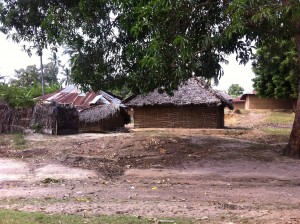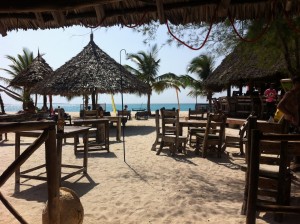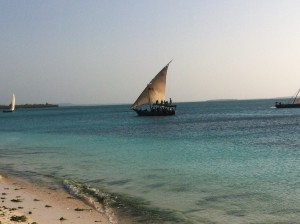Zanzibar is famous for its legendary beaches, some of the best and most beautiful in the world. There are coral reefs surrounding the islands of Unguja and Pemba, and these create a fine white sand on the beaches of most parts of the island. The fine, white sand, of course, leads to water that almost looks unreal. It is an intense turquoise blue that slowly fades into a deeper, darker blue as the seafloor slopes away from the beach. The beaches on the east side of the islands are the most spectacular as much of the western side coastline is covered with mangroves rather than beaches.
Naturally, these beaches attract crowds of tourists that flock down to the islands, mostly from Europe (particularly from England and Italy) to enjoy the natural wonders of Zanzibar and to stay at the exclusive resorts. Tourism is relatively new, there was very limited tourism before the Revolution and foreigners were virtually prohibited from going to the island during the first years of the Revolutionary government. Over the past few decades, though, the tourism industry has been increasingly developed across the islands, mostly on Unguja, and now it makes up 20% of the island’s GDP. Elegant resorts and hotels have been popping up along these amazing beaches, often at odds with the small fishing villages that have previously existed there. Tourism on Zanzibar, while necessary, has been quite problematic.
Last Saturday afternoon, I finally made an excursion out to one of these famed beaches, in the village of Kendwa on the northern tip of Unguja. Despite many of the problems that I have with the tourism industry, I do love tropical beaches. This is one of the perks of having an internship in Zanzibar. We spent a great day lying on the beach and swimming in the warm, turquoise water. It was wonderful, although afterwards, despite the layers of sunscreen that I put on, I nursed a bad sunburn.
Going out to the beach in Kendwa was jarring, though. The village is extremely poor, houses are made out of mud walls and have dirt floors, and has been shoved to one side of the dirt road while immediately on the other side, behind gates with security guards and large walls, are opulent resorts taking up all of the beachfront property. The village is obviously a fishing village, but now there is just one small trail that goes down to the beach along the side of one of the resorts, to where the boats of the villagers are dragged up on the southern end of the beach. It makes one wonder if the village was initially right on the beach and was pushed back by the resorts (I don’t know if this is true or not, but it sort of seems that way). Along the beach, sunburnt tourists stroll in string bikinis, while a few local women look on, completely covered and wearing hijab. It is a stark contrast and seems quite culturally inappropriate.
Additionally, the big resort on Kendwa beach, Kendwa rocks, is famed for its “Full Moon Party” a gigantic all night party celebrating the full moon. There is music, dancing, and lots of alcohol flowing. This is occurring in a fairly conservative Muslim society that frowns on the consumption of alcohol. Local restaurants never serve alcohol and there are very few stores that sell it, but it is very easy to get it at all of the restaurants and resorts aimed at tourists. Unless there is a large party going on at one of these tourist resorts, everything in Zanzibar shuts down fairly early. When these large parties and festivals turn into all night ordeals, this again goes against many of the cultural norms of the island.
But apart from the violations of cultural norms, the tourism industry doesn’t seem to benefit the majority of the population. Most of the island is made up of desperately poor, rural villages. Of course, the hotels do employ many locals and have provided a good source of income for them and their families, but unfortunately, many of the hotel employees actually come from mainland Tanzania where the levels of education are a lot higher. The tourism industry also provides a lot of exploitative employment as well. Walking around Stone Town and other resort areas, tourists are constantly accosted by street touts, referred to as papasi, offering tours, selling sunglasses and knick-knacks, and often peddling drugs. Sometimes it is even worse and more exploitative. When sitting in a bar one evening, I looked around and realized that two prostitutes had appeared on either side of me. This is the unfortunate aspect of tourism here that has negative implications on the culture, the environment and an economic impact that only benefits certain segments of the population.
The negative impacts of tourism have been demonstrated recently as there have been a couple of deadly attacks aimed at foreigners. Radical religious groups have been taking hold in some of the most vulnerable sectors of the Zanzibar population and have instigated some of these attacks. Two British girls walking around Stone Town had acid thrown at them last year and a French couple in a northern beachside village were murdered in their house last month. The general Zanzibar population has decried these attacks and is afraid of losing the tourism industry. But if the industry was run in a more responsible and less exploitative manner that benefitted more of the islands’ citizens, it could both support the local economy and allow foreigners to experience the cultural and natural wonders of Zanzibar.





